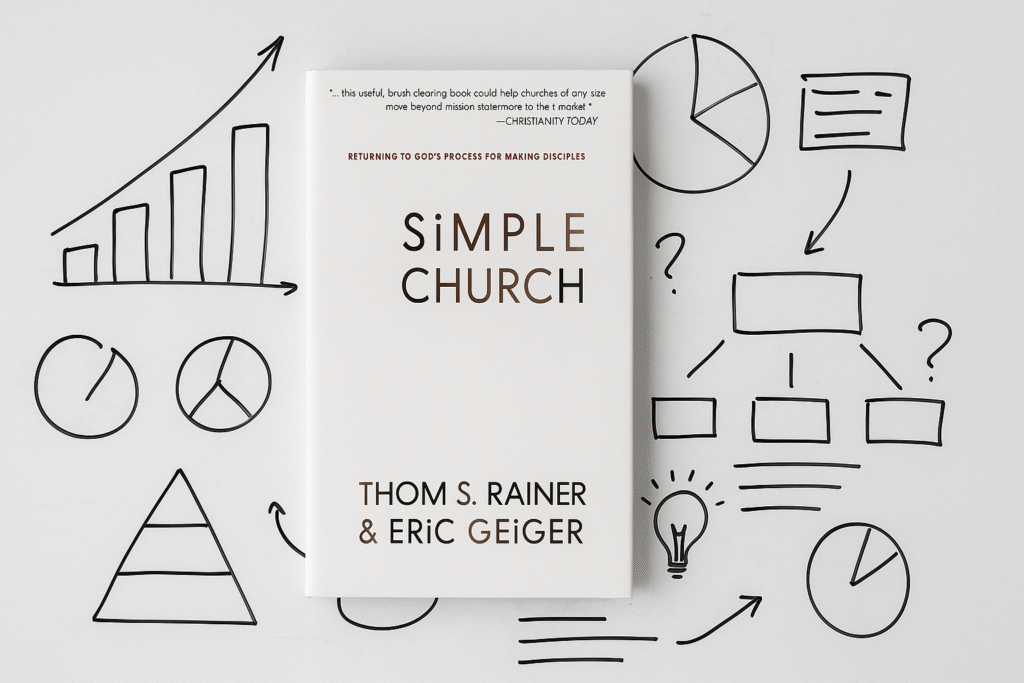
This review is of Simple Church by Thom S. Rainer and Eric Geiger, published in 2006 by B&H Publishing Group. Nearly two decades ago, this book challenged pastors and churches to embrace simplicity and clarity in their purpose, organizational ethos, and disciple-making goals. At the time, it became a bestseller and a staple in church leadership circles. For a while, it seemed like everyone was reading this book and talking about it. I remember everyone I knew in ministry was reading and discussing it during that time. Over the years, I have read it a few times since then. It was good to revisit again. Though I admit that reading it again slightly shifted my nostalgic view of this book. Also, I remarked that though some of the concepts are still around, it isn’t the revolutionary thing that individuals once claimed it was.
A Significant Shift Towards Simple Church
The authors highlight a significant shift among churches towards simplicity in our overtly complex and busy world. Early on in the book, the authors point out that people are hungry for simpler ways of church community, because the world has become chaotic and complex-and our lives have become busy. I have heard people say similar things – that they need their church community to be simple, because their lives are so overwhelmingly busy. Yet, I am not convinced that my experience has shown that people are serious about this conviction they say they have. The authors, offering examples from both large and small congregations that have adopted the somewhat identified principles within their communities, the authors make comparisons between churches that have clear discipleship processes and those that just tack programs and events on for the sake of ministry and for appearing healthy. I agree with the authors as they make the arguments that there is an increasing number of people who want simplicity and that “the clutter can often make things look OK, even good. The busyness is a great disguise for the lack of life. The complexity is a great cover-up.”[1] My experience would agree with their findings that “great amounts of activity do not produce life change. It only gives the impression that things are happening in the church community, that there is some level of spiritual life.
A Season of Ministry Schizophrenia
In their interviews, they find many churches are lost in “ministry schizophrenia.” This is a diagnosis they gave the local church, where “churches and church leaders are not sure who they are. They are not clear what their fundamental identity is. They run in a disjointed and frantic fashion.”[2] They also believe ministry schizophrenia “occurs most often when churches attempt to blend multiple church models into one.”[3] It is from this reality, almost twenty years ago, that they began to cultivate challenges to the evangelical church to be simpler. They strongly believe that “to have a simple church, you must design a simple discipleship process. This process must be clear.”[4] You must also be willing to say no to any idea that undermines that process. When clarity doesn’t exist, ministry schizophrenia takes place – and “ministry schizophrenia is not an environment conducive to spiritual transformation. People are pulled one way, then another.”[5] This is certainly happening in many large and traditional church communities.
A Disconnect and The Conversation
Although there are churches exemplified in this book as simple churches, the ones that are often celebrated for their streamlined discipleship models still operate within an attractional model—a somewhat counterproductive approach given the book’s emphasis on simplicity. I resonate with the book’s core message: a focus on clarity in vision, mission, and discipleship, ensuring the church’s activities revolve around a cohesive discipleship model. However, Simple Church touches only lightly on ecclesiology, certainly leans into the trap of church growth paradigms, and primarily offers research on the productivity and effectiveness of churches that have embraced a clearer and simpler “why.” Despite being grounded in substantial research—including input from over 300 churches, as the authors note, with “319 churches participating in the first stage, 166 from the vibrant/growing group and 153 from the comparison group”—the book’s approach is, at times, almost too simplistic.[6] I think greater research needs to be done on this conversation, perhaps from individuals not interested in the outcome.
This book remains an accessible, straightforward read, full of insights from real-life case studies. It invites readers to consider a simpler, clearer approach to church, where every aspect is guided by a “simple process for making disciples.”[7] Overall, the book sparked a conversation about simpler church practices that continue today, with the authors raising questions about simplicity and a less consumer-driven approach to ministry that the church is still exploring. However, the book falls short of going deeper into scriptural models of church community and mission, and it stops short of offering a truly fresh framework for local church communities.
About Thom S Rainer & Eric Geiger
Both authors have established strong reputations in church leadership. Thom S. Rainer, a former pastor, is the president and CEO of LifeWay Christian Resources, a best-selling author, church coach, researcher, and speaker. Similarly, Eric Geiger is the senior pastor of Mariners Church in Southern California, one of the nation’s largest and most recognized churches. Before leading Mariners, Eric served as senior vice president of LifeWay Christian Resources, held roles as an executive and teaching pastor in Miami, and frequently consulted with ministry leaders on mission and strategy. He holds a doctorate in leadership and church ministry from Southern Seminary. Though both leaders have championed the concept of simpler church and defined it in helpful ways, they each lead very large, complex organizations, which feels somewhat contradictory to the simplicity they advocate.
Why I Read Simple Church
I first read this book when it was released, but recently revisited it many times, including recently to see how its insights align with my evolving ecclesiology. Admittedly, I had a somewhat romanticized view of the book from my earlier reading. I know it influenced my leaning toward simpler, smaller church models and the discipline of saying “no” to programs and events that would have created complexity within church contexts. As I remembered from reading the first time, the authors strongly emphasize essential reminders: the importance of offering clear discipleship processes, creating movement, orchestrating ministry alignment, and keeping discipleship central to the church’s mission.
A Misplaced Starting Place
Now, reading it again, I noticed how much the discernment the authors encourage around church mission is driven solely by church leadership, without incorporating input from church members who are partners in the mission. The authors use language suggesting that it’s the leadership’s job to build, execute, define, and discern its mission, yet there’s little emphasis on listening to what God may be placing on the hearts of those within the church community or on integrating them into the mission—there is only thoughts on how to get them on board with it (onboarding and integration techniques). I believe that an ecclesiology centered on the idea that our role is to “build” lives, rather than to create space for God to work in, with, and through our lives and programs, is certainly a poor foundation for any approach that follows a belief that ministry is all about discipleship. Even more, the idea that it is our responsibility to “determine what kind of disciple you wish to produce in your own church,” and “What do you want the people to be?” all of which feel like a bad starting place.[8] It is not our “own church,” nor is it our responsibility to name a target audience – that is God’s place.
What I Appreciate
In re-reading this book, I appreciate the challenge to have a clear and simple process for discipleship. Additionally, I don’t think people progress through discipleship “because they hear it from the pulpit,” nor because “they see a purpose statement on the wall,” but rather it is “relationships [that] bridge the process.”[9] I also appreciate building a desired movement through discipleship, helping people find “greater levels of commitment” and “ever-increasing levels of discipleship.”[10] For far too long, we have built churches on a large and fast menu approach, telling our church communities they can have it all and have it their own way. The research shows “fast-food spirituality is not healthy. The large and fast menu approach to ministry is killing our churches; few people are debating that, but many aren’t allowing God to transform their ministry towards better ways. The appropriate response: Stay focused on your simple process to discipleship and boldly say no to everything else that comes your way. Perhaps this is one of the greatest things we can do as a church community: abandon everything that God is not calling your church community to.
Simple Church: A Relevant Resource
This book remains relevant today as a foundational text for churches and leaders seeking clarity and focus in ministry amidst an often over-complicated world. Its research-driven insights on simplicity and alignment in discipleship processes continue to resonate with church communities aiming to eliminate busyness and distractions to create impactful, intentional discipleship. I recommend this book to leaders who are new to church strategy or who are reevaluating their ministry frameworks to re-center on mission. While the book may lack research, theological, and academic depth in areas such as ecclesiology and collaborative mission discernment, it serves as an excellent starting point for conversations about streamlining church life. For deeper study, I suggest reading this book alongside resources that explore more nuanced ecclesiological models, which can help guide a community-driven and spiritually formative approach to church mission.
[1] Thom S. Rainer and Eric Geiger, Simple Church (Nashville, TN: B&H Publishing Group, 2006), 20.
[2] Thom S. Rainer and Eric Geiger, Simple Church (Nashville, TN: B&H Publishing Group, 2006), 21.
[3] Thom S. Rainer and Eric Geiger, Simple Church (Nashville, TN: B&H Publishing Group, 2006), 21.
[4] Thom S. Rainer and Eric Geiger, Simple Church (Nashville, TN: B&H Publishing Group, 2006), 26.
[5] Thom S. Rainer and Eric Geiger, Simple Church (Nashville, TN: B&H Publishing Group, 2006), 22.
[6] Thom S. Rainer and Eric Geiger, Simple Church (Nashville, TN: B&H Publishing Group, 2006), 65.
[7] Thom S. Rainer and Eric Geiger, Simple Church (Nashville, TN: B&H Publishing Group, 2006), 55.
[8] Thom S. Rainer and Eric Geiger, Simple Church (Nashville, TN: B&H Publishing Group, 2006), 115.
[9] Thom S. Rainer and Eric Geiger, Simple Church (Nashville, TN: B&H Publishing Group, 2006), 151.
[10] Thom S. Rainer and Eric Geiger, Simple Church (Nashville, TN: B&H Publishing Group, 2006), 139.



